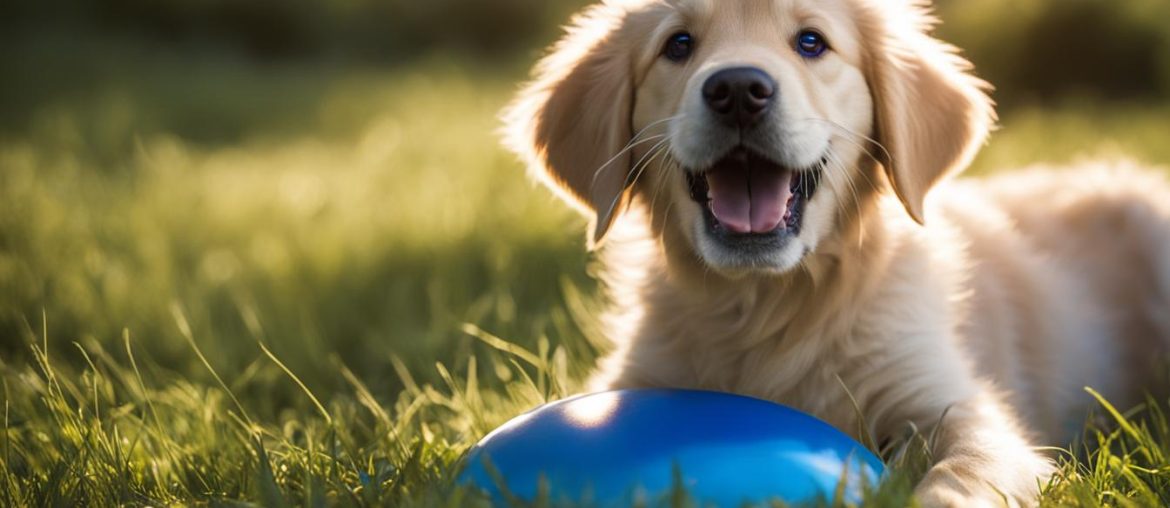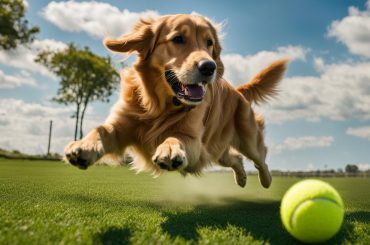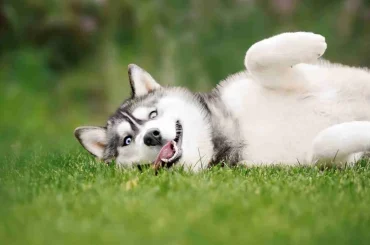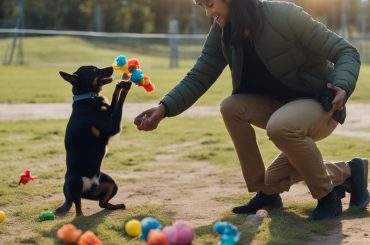Teaching your dog to find toys can be a fun and rewarding activity. By utilizing their natural scenting abilities, you can engage your dog in a challenging brain puzzle that provides mental stimulation and strengthens the bond between you and your furry friend. In this article, we will explore a three-step guide to teach your dog to find their toys, using methods derived from different sources.
Key Takeaways:
- Dog toy training is a rewarding and engaging activity for both you and your pet.
- Teaching your dog to find toys stimulates their cognitive abilities and prevents boredom.
- Consistent toy names and positive reinforcement are crucial for successful training.
- Gradually increase the difficulty level of the game to keep your dog challenged.
- The “find it” game can provide mental stimulation and enrichment for your dog.
The Importance of Mental Stimulation for Dogs
Dogs not only need physical exercise, but also mental stimulation to thrive. Engaging your dog’s mind through brain puzzle games, such as teaching them to find their toys, can provide numerous benefits. Mental exercise can improve their problem-solving skills, prevent boredom, and enhance their overall well-being. By challenging their cognitive abilities, you can keep your dog mentally sharp and entertained.
Brain puzzle games like toy finding require your dog to use their senses and think strategically. As they search for their toys, they tap into their natural instincts and abilities. This type of mental stimulation can help alleviate boredom and reduce any destructive behaviors that may arise from a lack of engagement.
Engaging your dog’s mind through toy finding also strengthens the bond between you and your furry friend. It creates an opportunity for interactive play and positive reinforcement. When your dog successfully finds their toys, you can celebrate their achievement and reward them with praise, a toy, or a treat. This positive reinforcement further motivates your dog and encourages them to continue engaging their mind.
The Cognitive Abilities of Dogs
Dogs are highly intelligent creatures with pretty good cognitive abilities. They have a strong sense of smell, which allows them to differentiate scents and track down objects. Their ability to learn and remember commands, names, and routines is impressive. By engaging their cognitive abilities through mental stimulation, you can tap into their potential and help them reach new levels of intelligence and problem-solving.
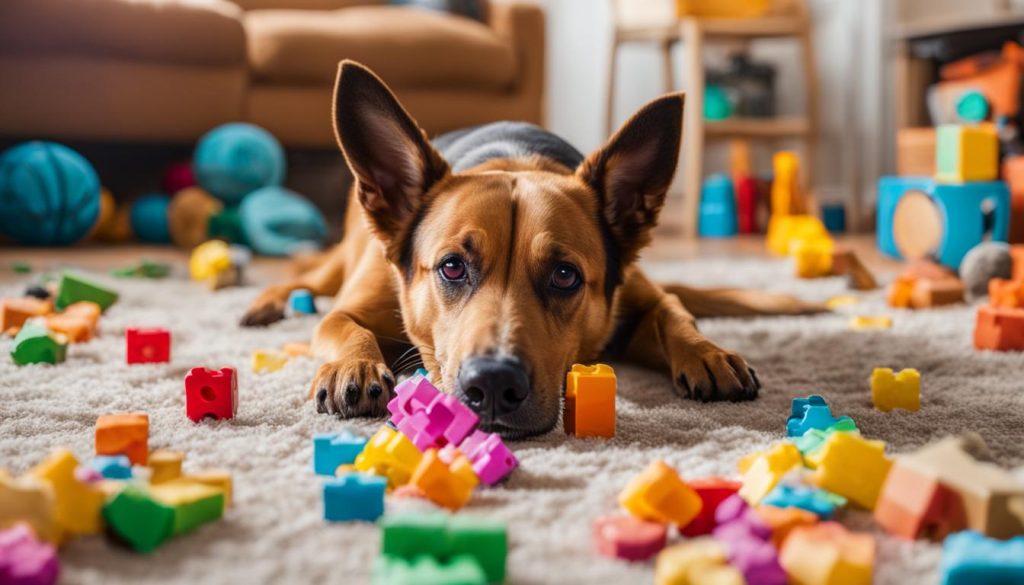
| Benefits of Mental Exercise for Dogs | Brain Puzzle Games for Dogs |
|---|---|
|
|
Naming and Consistency
When teaching your dog to find their toys, establish consistent names for each toy. Consistency in naming helps your dog understand and differentiate between different toys. You can choose descriptive names that highlight the toy’s characteristics or unique names that are easy to remember. The key is to use the same name consistently for each toy.
To ensure consistency, it can be helpful to keep a list of toy names. This list serves as a reference for you and helps you avoid confusion when communicating with your dog. By referring to the list, you can easily remember and use the correct name for each toy during training sessions or playtime.
Consistent naming not only helps your dog learn and remember the names of their toys, but it also enhances their overall understanding of commands and cues. They will associate a specific name with a particular toy, making it easier for them to locate and retrieve the desired toy when given the command.
Examples of Consistent Toy Names
| Toy Type | Consistent Name |
|---|---|
| Tennis Ball | Ball |
| Plush Squirrel | Squirrel |
| Rope Toy | Rope |
| Chew Bone | Bone |
By following a consistent naming approach, you can effectively teach your dog to associate specific names with their toys, making the toy finding training more successful and enjoyable for both of you.
Steps to Teach Your Dog Toy Names
Teaching your dog to identify different toys by name is a rewarding and fun activity that strengthens the bond between you and your furry friend. By following a step-by-step guide, you can effectively teach your dog toy names and enhance their toy finding skills. Here’s how:
Step 1: Start with their favorite toy
Begin the training by using your dog’s favorite toy as the starting point. This will increase their motivation and engagement in the learning process. Choose a toy that your dog is highly interested in and familiar with.
Step 2: Gradually increase difficulty
Once your dog understands the concept of associating a name with their favorite toy, you can gradually increase the difficulty level. Introduce new toys with different names and ask your dog to retrieve the specific toy based on its name. Start with easy-to-distinguish toys and gradually progress to more similar-looking toys.
Step 3: Reward correct responses
Consistently reward your dog for correctly identifying and retrieving the toy with its corresponding name. Use positive reinforcement techniques, such as treats or praise, to reinforce their correct responses. This will encourage your dog to continue learning and improve their toy finding skills.
By following these steps, you can effectively teach your dog toy names and enhance their ability to locate and retrieve specific toys. Try to be patient, consistent, and reward your dog for their progress. Happy training!
Developing Your Dog’s Vocabulary
Expanding your dog’s toy vocabulary is an important part of their toy finding training. Once your dog has learned the names of a few toys, you can continue to build their vocabulary by introducing new toy names. Repetition and practice are key to helping your dog remember and maintain the names they have already learned.
Regular practice sessions where you reinforce their knowledge of toy names will help them solidify their understanding. Start by reviewing the names of the toys they already know and then introduce one or two new toy names at a time. Use consistent and clear cues to help them associate the name with the toy.
Building on their existing knowledge is essential for your dog’s continued growth in toy finding skills. As they become more proficient, you can gradually increase the difficulty level by adding new toys to the search area. This challenges them to use their scenting abilities to identify and retrieve specific toys from a larger selection. By building on what they already know, you can continue to engage and stimulate your dog’s mind.
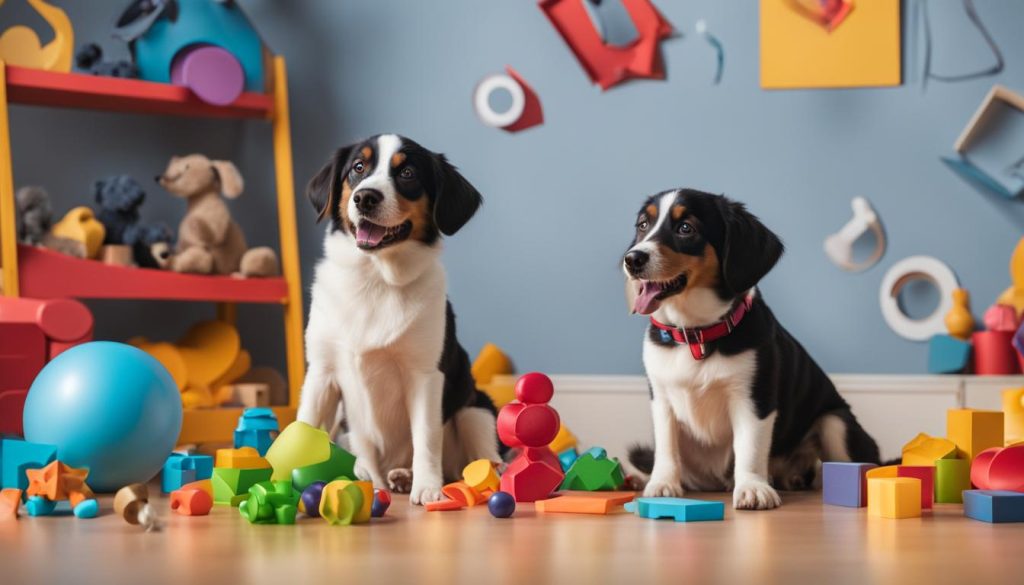
Tips for Expanding Your Dog’s Toy Vocabulary:
- Review previously learned toy names regularly
- Introduce one or two new toy names at a time
- Use consistent and clear cues to associate the name with the toy
- Gradually increase the difficulty by adding new toys to the search area
“Repetition and practice are key to helping your dog remember and maintain the names they have already learned.”
| Toy Name | Description |
|---|---|
| Tennis Ball | A standard yellow tennis ball |
| Tug Rope | A sturdy rope toy for tug-of-war |
| Squeaky Duck | A plush toy that makes a squeaking sound |
| Chew Bone | A durable bone-shaped toy for chewing |
Rewarding Your Dog’s Success
When teaching your dog to find their toys, you should reward their success to reinforce positive behavior. Some dogs are highly motivated by toys, making them great candidates for using toys as rewards during training. For these toy-motivated dogs, you can gradually phase out treats and use their favorite toy as a reward for finding the correct toy.
To transition from treats to toys as rewards, start by using both treats and toys during training sessions. When your dog successfully finds and retrieves the correct toy, reward them with both praise and a treat. Over time, you can gradually reduce the use of treats and increase the emphasis on using toys for play as a reward for finding the designated toy.
However, you should note that not all dogs are equally motivated by toys. If your dog is not strongly toy-motivated, it is perfectly fine to continue providing treats as positive reinforcement when they successfully find the correct toy. The main goal is to find the reward system that works best for your individual dog, whether it be toys, treats, or a combination of both.
To ensure that your dog remains engaged and motivated during toy finding training sessions, you should provide variety in the toys you use. Offer a selection of different types of toys, such as squeaky toys, plush toys, or interactive puzzle toys, to keep their interest high. Try to always supervise your dog during playtime and choose toys that are safe and appropriate for their size and chewing habits.

Summary
- For toy-motivated dogs, you can phase out treats as rewards and use their favorite toy for play as a reward for finding the designated toy.
- Gradually reduce the use of treats and increase the emphasis on using toys as rewards during training sessions.
- If your dog is not motivated by toys, continue to provide treats as positive reinforcement.
- Provide variety in the toys you use to keep your dog engaged and motivated.
Table: Rewarding Strategies for Toy-Motivated Dogs
| Reward Strategy | Method |
|---|---|
| Phasing out treats | Gradually reduce the use of treats and increase the focus on using toys for play as a reward for finding the correct toy. |
| Combining treats and toys | During training sessions, reward your dog with both treats and toys when they successfully find and retrieve the correct toy. |
| Continuing to provide treats | If your dog is not strongly motivated by toys, it is perfectly fine to continue using treats as positive reinforcement. |
| Variety in toys | Offer a selection of different types of toys to keep your dog engaged and motivated during training sessions. |
Building Puzzle Skills
Once your dog has mastered the basics of finding their toys, you can start challenging them by increasing the difficulty level. One way to do this is by adding more toys to the search area. This not only enhances their problem-solving skills but also teaches them how to differentiate between different toys based on their names.
Another technique to build puzzle skills is to teach your dog toy retrieval and organization. Start by instructing them to bring the toy to a designated spot, such as a basket or crate. Gradually increase the distance or introduce obstacles that your dog must navigate to retrieve the toy. This helps your dog develop their spatial awareness and problem-solving abilities.
To further enhance their toy finding skills, try hiding toys in different rooms of your home. This introduces an additional level of challenge as your dog has to navigate through different environments and rely on their scenting abilities to locate the toy. Make sure to start with familiar rooms and gradually progress to less familiar ones.
| Increasing Difficulty in Toy Finding | Adding More Toys to the Search | Teaching Toy Retrieval and Organization | Finding Toys from Different Rooms |
|---|---|---|---|
| Gradually increase the complexity of the game | Introduce more toys to the search area | Instruct your dog to bring the toy to a designated spot | Hide toys in different rooms of your home |
| Challenge your dog’s problem-solving skills | Enhance your dog’s ability to differentiate between toys | Develop your dog’s spatial awareness | Improve your dog’s scenting abilities |
By gradually increasing the complexity of the game and incorporating these techniques, you can continue to challenge and stimulate your dog’s problem-solving abilities. Try to always provide positive reinforcement and reward your dog for their success. With patience and practice, your dog will become a master at finding their toys.

Testimonials
“My dog absolutely loves the challenge of finding his toys in different rooms. It keeps him mentally sharp and entertained!” – Sarah, dog owner
“Teaching my dog toy retrieval and organization has been a game-changer. Now, he not only finds his toys but also knows where to put them after playtime!” – Mark, dog owner
Introducing the “Find It” Game
Teaching dogs the “find it” cue is a fun and interactive way to engage their natural scenting abilities. This game involves hiding toys in plain sight and encouraging your dog to find them when given the cue. By gradually progressing to semi-blind finds and celebrating their successes, you can enhance your dog’s toy finding skills and provide them with mental stimulation.
The “find it” game begins by introducing the concept of searching for a hidden toy. Start with a toy your dog is familiar with and place it in an obvious location, such as on the floor. Use a cue, like “find it” or “search,” and let your dog sniff out the toy. When they successfully locate the toy, celebrate their achievement with praise or a treat. Repeat this exercise several times to reinforce the association between the cue and finding the toy.
Once your dog is comfortable finding toys in plain sight, you can progress to semi-blind finds. This involves hiding the toy in more challenging locations, such as behind furniture or under a blanket. Start with easy hiding spots and gradually increase the difficulty level as your dog becomes more proficient. Continue to use the cue and reward your dog for successfully finding the hidden toy. Try to celebrate their successes and make the game exciting and rewarding for them.

Tips for Success:
- Start with a favorite toy to build initial interest and motivation.
- Use a consistent cue, such as “find it” or “search,” to signal the start of the game.
- Gradually increase the difficulty by hiding toys in more challenging locations.
- Celebrate your dog’s successes with praise, treats, or playtime.
Upping the Ante in the “Find It” Game
As your dog becomes more proficient in finding hidden toys, it’s time to up the ante and increase the difficulty level of the “find it” game. This will keep your dog engaged, mentally stimulated, and challenged. One way to do this is by using previous hiding spots that your dog has already become familiar with. By reintroducing these spots, you can gradually increase the difficulty by making the hiding spots more complex.
Another strategy to raise the difficulty level is by introducing completely new hiding spots. This will require your dog to rely solely on their scenting abilities and problem-solving skills to locate the hidden toy. Get creative with your hiding techniques by utilizing different rooms, elevating the hiding spots, or incorporating obstacles that your dog needs to navigate through. This will provide a fresh and exciting challenge for your dog.
To summarize, increasing the difficulty in the “find it” game involves using previous hiding spots to start and then introducing completely new and challenging hiding spots. These creative hiding techniques will enhance your dog’s scenting abilities, problem-solving skills, and overall mental stimulation.

| Benefits of Upping the Ante | Creative Hiding Techniques |
|---|---|
|
|
The “Find It” Game as Mental Stimulation and Enrichment
The “find it” game offers numerous benefits for your dog, providing both mental and physical exercise. One of the major advantages of this game is its ability to help your dog relax in unfamiliar situations. By engaging their natural scenting abilities, the game helps redirect their focus and provides a comforting and familiar activity, reducing anxiety and stress levels.
In addition to relaxation, the “find it” game is an excellent way to provide mental stimulation during mealtime. Instead of serving your dog’s meals in a traditional bowl, scatter their kibble around the house or use a food puzzle toy. This not only makes mealtime more exciting, but it also engages their problem-solving skills as they search for their food.
Another way to incorporate the “find it” game into your dog’s routine is through hide-and-seek playtime. This playful activity not only stimulates their mind but also enhances their physical exercise as they actively search for hidden toys. It’s a great way to keep them entertained and provide a fun bonding experience for both of you.
| Benefits of the “Find It” Game |
|---|
| Relaxation in unfamiliar situations |
| Mental and physical exercise |
| Mental stimulation during mealtime |
| Hide-and-seek playtime |
Overall, the “find it” game is a versatile and enjoyable activity that offers numerous benefits for your dog. It not only provides mental stimulation and physical exercise but also promotes relaxation and enhances mealtime. Incorporating this game into your dog’s routine can contribute to their overall well-being and strengthen the bond between you and your furry friend.
If you want to see a complete table, scroll to the bottom of the article.
Final Thoughts
Teaching your dog to find their toys is a rewarding and engaging activity that provides mental stimulation and strengthens the bond between you and your furry friend. By following the steps outlined in this article, you can develop your dog’s toy finding skills and provide them with the mental exercise they need to thrive.
Consistency is key when it comes to teaching your dog toy names. Use the same name for each toy and keep a list to avoid confusion. Gradually increase the difficulty level and reward your dog for correctly identifying and retrieving the toy. Positive reinforcement is crucial in helping your dog learn and progress in their toy finding skills.
As your dog becomes proficient in finding toys, you can up the ante by adding more toys to the search, teaching toy retrieval and organization, and challenging them to find toys from different rooms. The “find it” game is a great way to encourage your dog’s natural scenting abilities, and you can gradually increase the difficulty by hiding toys in more challenging locations.
Incorporating the “find it” game into your daily routine not only provides mental stimulation for your dog but also offers various benefits such as relaxation in unfamiliar situations and mental and physical exercise. Make mealtimes more enriching by scattering your dog’s kibble or using a food puzzle. And don’t forget to include “find it” in your playtime activities with hide-and-seek games.
FAQ
How do I teach my dog to find their toys?
You can teach your dog to find their toys by following a three-step process, which involves introducing toy names, increasing difficulty, and providing positive reinforcement.
Why is mental stimulation important for dogs?
Mental stimulation is important for dogs because it improves problem-solving skills, prevents boredom, and enhances overall well-being.
Do I need to have consistent names for each toy?
Yes, have consistent names for each toy to avoid confusion. Keeping a list of toy names can be helpful in maintaining consistency.
How do I teach my dog toy names?
Start with their favorite toy and gradually introduce the name. Increase difficulty and reward your dog for correctly identifying and retrieving the toy.
Can I expand my dog’s toy vocabulary?
Yes, you can expand your dog’s toy vocabulary by introducing new toy names and regularly practicing and repeating the names they have already learned.
What if my dog is not motivated by toys?
If your dog is not strongly motivated by toys, you can continue to provide treats as positive reinforcement when they successfully find the correct toy.
How do I increase the difficulty of the game?
You can increase the difficulty of the game by adding more toys to the search area, teaching your dog to retrieve and organize their toys, and challenging them to find toys from different rooms.
How do I introduce the “find it” game?
Start by hiding a toy in plain sight and releasing your dog to find it when given the cue. Gradually progress to semi-blind finds in more challenging locations.
How do I up the ante in the “find it” game?
You can up the ante in the “find it” game by using previous hiding spots and introducing completely new hiding spots that rely solely on your dog’s scenting abilities.
What are the benefits of the “find it” game?
The “find it” game offers relaxation in unfamiliar situations, mental and physical exercise, mental stimulation during mealtime, and can be incorporated into playtime with hide-and-seek activities.


